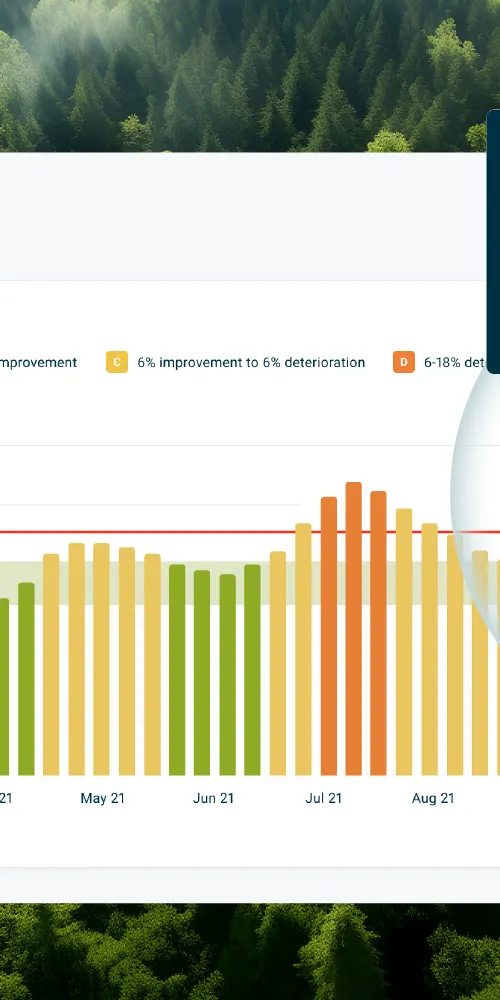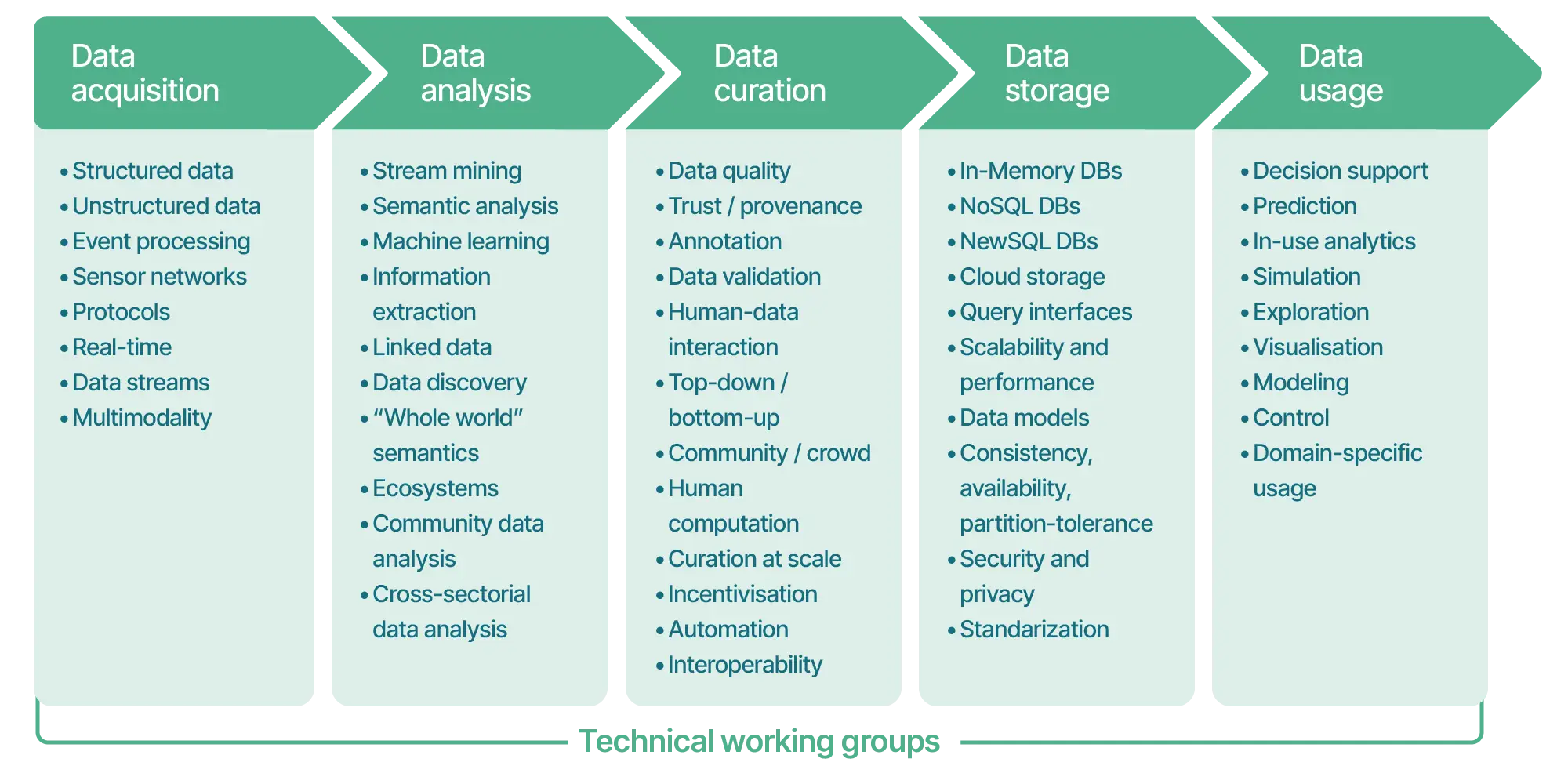Navigating the sea of big data: How to manage and utilise IoT data in "smart shipping"

As the maritime industry sails into the digital era, the Internet of Things (IoT) has emerged as a potential game-changer. Initially, it focused on basic navigational tracking and monitoring, with Automatic Identification Systems (AIS). However, with access to improved technology, IoT now plays a crucial role in 'smart shipping’ enabling shipping companies to embrace methods of high-frequency data (HFD) collection.
HFD provides continuous updates on vessel performance based on sensor-collected data. Because of its frequency, HFD data is far richer and more granular than the data currently available on most vessels. This level of detail optimises operations, enhances safety and improves efficiency.
See below: The Big Data Value Chain (Curry et al. 2014)

Data value chain
Harnessing and processing such massive amounts of data – known as big data – are not without their challenges. Issues such as data quality, data security, data privacy and a lack of skilled personnel can hamper data analysis efforts. Furthermore, the maritime industry has deeply ingrained traditions and vast operational complexities, which means it can be resistant to adopting new technologies.
However, finding a way to effectively manage big data and extract knowledge is no longer a luxury. It’s an essential part of modern maritime, in order to meet increasing regulations and stay competitive.
There are five major stages to turning raw data into meaningful and actionable information. This flow of information is known as the data value chain. Think of it as the full lifecycle of your data, from collection to analysis and usage.
According to Edward Curry, established Professor of Data Science and Director of the Insight SFI Research Centre for Data Analytics, and the Data Science Institute at University of Galway, these are the five steps:
- Data acquisition
- Data analysis
- Data curation
- Data storage
- Data usage
Blind leading the blind
Numerous companies are venturing into the realm of sensor data, yet few have the expertise needed to fully leverage these technologies. The complexity of setting up sensors and processing the results necessitates a unique mix of data and maritime expertise, which few companies offer.
Successful IoT implementation in shipping needs a strategic approach, which considers the customer’s needs, and ensures that the entire data value chain is optimised for specific business objectives.
Here's a breakdown of the challenges:
- Cultivating data literacy
The data value chain is more than just following technical steps. Achieving ROI with data requires significant cultural changes. Cultivating data literacy and promoting data democratisation - where data is shared among all stakeholders - are key parts of the success equation.
- Understanding customer objectives
Before collecting and processing data, it's crucial to have a clear understanding of the customer's objectives. Raw sensor data needs to be processed and customised based on these specific outcomes or goals. This tailored processing ensures that the data aligns with the desired recommendations.
- Avoiding ineffective data collection
Without a clear understanding of customer objectives, there's a risk of spending significant resources on collecting data that may not be effectively utilised or even needed. This inefficiency can arise if the data collected doesn't align with the specific needs of the business.
- Interoperability
In the maritime industry, data often comes from various sources and in different formats. The lack of standardisation and interoperability between these systems can cause significant challenges when analysing data. Without effective integration valuable insights may be hidden in data silos.
- Challenges of generic sensor packages
Sensor packages that are not optimised for the unique data processing requirements of a business, can lead to challenges. Different departments may require different information, and generic data may not cater to these varied needs.
- Issues with handovers
If the data is not well-understood, or if there's a lack of optimisation for specific business processes, necessary insights may be missed when handing over data between departments.
Emerging trends in maritime operations
According to a recent review on data analysis in maritime IoT applications, advancements in technology and increasing demands for efficiency, safety and sustainability in shipping are driving an evolution of big data analysis. To enable this transition, sophisticated data analytics and techniques are required.
Edge computing: this computing revolutionises IoT by giving devices greater autonomy. Instead of transmitting data to a centralised server, IoT devices under edge computing store, process and analyse data locally. Bringing these processes closer to the device enhances the efficiency of IoT devices, by reducing network traffic and latency, which enables real-time insights.
Machine learning and artificial intelligence: ML and AI are increasingly used to analyse big data. These techniques automate the analysis process, extracting insights from large datasets that might be missed by traditional analysis methods.
Real-time analytics: Instant insights enable quick, informed decision-making, which are essential for navigation, safety monitoring and incident response.
Cyber security analytics: With increased reliance on IoT, maritime cyber security is critical. Cyber security analytics uses data analysis to detect and prevent cyber threats.
Data fusion: Maritime IoT involves multiple sensors and data sources. Data fusion combines this data for more accurate insights, which enhances navigation and monitoring and enables strategic decision-making.
The right software partner
A recent study by Dalaklis et al. (2023) explores the role of technologies, such as AI, big data analysis and IoT, in revolutionising operations within the shipping industry. The authors state that the right software tools, using advanced algorithms, are needed to perform statistical analyses and extract and process relevant information. This is why finding the perfect software partner is essential.
ZeroNorth Edge is ZeroNorth’s HFD solution, which offers the most advanced solution for integrating ALL electronic sensors on your vessel. Using the latest technology, ZeroNorth Edge ensures that data is not just collected, but also compiled, validated and prepared for actionable insights. By establishing a robust infrastructure onboard, we enable quick and cost-effective installation, feeding our advanced analytics.
This ensures ship owners and charterers have a one-stop solution for all their data needs. With Edge, you're not just meeting regulatory requirements; you're setting sail towards a more profitable and greener future.
Holistic solutions for diverse fleets
What makes the ZeroNorth platform such a game-changer, isn’t just the technology it uses, it’s the way we approach data. With our unique offering of experienced data scientists and a wealth of maritime industry experience, we look at data differently.
ZeroNorth recognises the diversity inherent in shipping fleets, stemming from different orientations, shipyards and histories. Therefore, we start with the business problem at hand, whether it's choosing the right vessel, planning routes, or deciding where to bunker. Data analysis is then reverse engineered to ensure the right data is collected from the appropriate sensors.
This unique approach of working backward through the data value chain allows ZeroNorth to tailor data gathering to meet specific business needs. This avoids the common pitfall of collecting data that can't be effectively utilised, a scenario often encountered by companies focusing solely on acquiring generic sensor packages.
Open and collaborative systems
Our customers are at the centre of all we do. It’s all about making your business more productive and more sustainable. To ensure seamless data integration and maximise the benefits of data analysis in maritime IoT our platform provides a one-stop-shop that offers holistic visibility into fleet performance.
In addition to offering visibility for all stakeholders, the platform allows for collaboration with third-party systems. This customer-centricity includes the ingestion of data from other monitoring software companies, ensuring that shipping companies can seamlessly utilise existing solutions.
ZeroNorth's interoperability extends to working with third party monitoring systems, acknowledging that these systems play a vital role in sensor data collection. This open approach stands in contrast to the data silos, which are an on-going issue in the shipping industry.
In the realm of IoT implementation in maritime operations, ZeroNorth exemplifies forward-thinking and innovation, while always putting the customer first. Our unique combination of industry know-how and data expertise means we are able to effortlessly guide your business through the data value chain, and provide practical, effective, simple solutions for the industry's digital transformation.